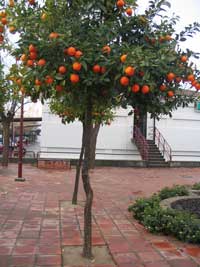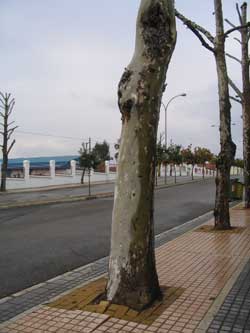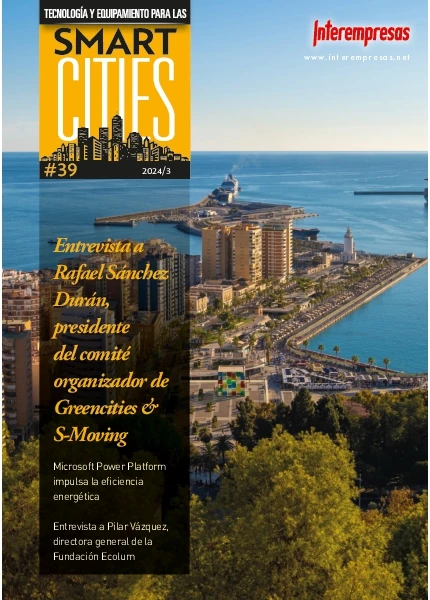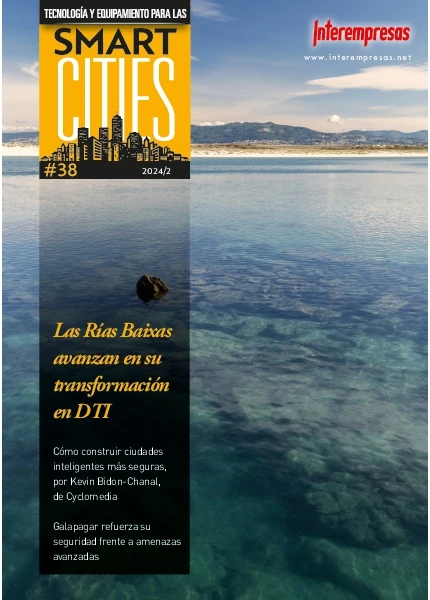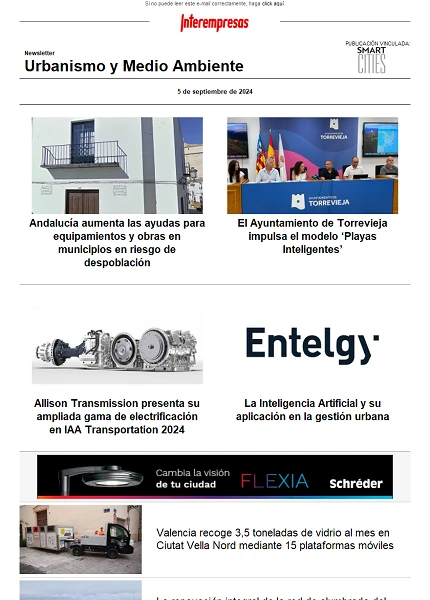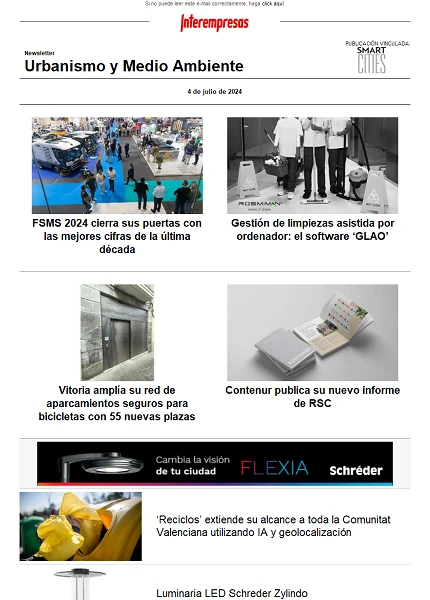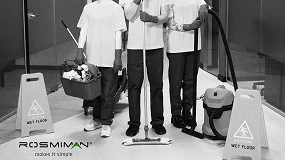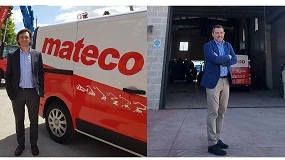A lo largo de la historia, los criterios urbanísticos han priorizado la cantidad sobre la calidad
El árbol en el entorno urbano
25 de mayo de 2008
Utilizado de forma aislada, formando pequeños grupos, en grandes masas o formando alineaciones en calles, el árbol permite demarcar límites y zonas, proporcionar aislamiento o crear barreras visuales, proteger del viento, del sol o del ruido, embellecer o dar sombra en espacios de recreo.
En la ciudad, la anchura de las calles no siempre permite dejar crecer el árbol libremente, además la calidad del suelo no es siempre la óptima.
De hecho, el árbol en la ciudad está sometido a situaciones de estrés permanente y, en general a condiciones radicalmente distintas a las que tendría en su medio natural, por lo que los planes municipales, a la hora de abordar la integración urbanística de este elemento vivo, deberán contemplar cuestiones como el carácter y las limitaciones de las numerosas especies existentes, así como el entorno en el que se ubicarán, las características del suelo, el clima o la polución que deban soportar.
Árbol adecuado al espacio pero alcorque insuficiente.
¿Quién da más?
Históricamente, desde que, con la llegada de la democracia, los espacios verdes en la ciudad cobraron importancia y fueron considerados elementos vertebradores dentro de los ejes urbanos, los criterios urbanísticos en materia de implantación de espacios verdes han tenido más que ver con la cantidad que con la calidad. Los responsables políticos, en su afán por atender la voluntad del ciudadano –por razones obvias–, que ha venido reclamando la presencia tanto de zonas verdes como de arbolado viario, ha ‘vendido’ sus acciones en este terreno en forma de cifras: metros cuadrados, número de árboles plantados… Así, en las grandes urbes de nuestro país la ciudadanía ha visto cómo en las últimas décadas a las calles de la ciudad les iban siendo concedidas a cada una su propia hilera de árboles. En apenas unos años pasamos a vivir en ciudades parcheadas de árboles plantados por doquier de manera indiscriminada. Así nos lo cuenta Dina Alsawi presidenta de la Asociación de Profesionales de los Espacios Verdes de Cataluña y técnica de Jardinería de la Mancomunidad de Municipios del Área Metropolitana de Barcelona: “Se perseguía una imagen anglosajona que no podemos pretender con nuestras características tanto de dimensión como climáticas; es evidente que la presencia del arbolado viario es incuestionable, el ciudadano lo reclama y es un elemento de ordenamiento y un delimitador del espacio excepcional, pero no debe ser plantado en todas partes… El árbol debe ubicarse en vías anchas, en las que tenga espacio para desarrollarse de forma aérea, donde pueda ser mantenido y controlado con un coste y un consumo energético mínimo.”
Existen en nuestras ciudades demasiadas plantaciones lineales realizadas en hoyos pequeños y sobre suelos inapropiados
En el mismo sentido se manifiesta Xavier Fàbregas, profesor titular de Jardinería y Paisajismo de la Escuela Superior de Agricultura de Barcelona, de la Universidad Politécnica de Cataluña. Fàbregas nos explica que “siendo la ciudad un medio agresivo para la vegetación, tanto por las condiciones bioclimáticas como por el espacio, deben buscarse especies que vivan bien en el entorno urbano. Árboles que puedan crecer, a los que pueda darse lo que necesitan, invertir en pavimento nuevo que permita la viabilidad del crecimiento de las raíces, invertir en una tierra de calidad y comprar árboles también de calidad, esto es, que estén bien cultivados, así como replantearse el diseño urbanístico, proyectando aceras más anchas y buscar crecimientos en portes naturales sin tantas intervenciones”.
Como consecuencia de la falta de planificación, de la incorrecta preparación del suelo o de la inadecuada selección de especies el panorama urbano ha ido arrojando ejemplos de árboles débiles o enfermos, otros mal anclados al terreno y que caen fácilmente con los vientos fuertes, árboles podados drásticamente para evitar molestias a los vecinos de las viviendas colindantes, raíces que invaden conducciones, levantan pavimentos y agrietan muros… Otros errores habituales a la hora de ubicar el arbolado vial son la falta de protección del tronco en algunos puntos conflictivos como la entrada de un vado, la interferencia con la señalización vertical o semáforos o la falta de previsión en el mantenimiento.
La asombrosa resistencia de este ser vivo hace que sea considerado casi inmortal…, así que en la idea de que el árbol aguanta “lo que le echen”, nos encontramos demasiadas veces con un panorama de arbolado antiestético y disfuncional. Y es que el entorno del arbolado urbano es hoy mucho más hostil que el de hace medio siglo atrás: pavimentaciones más estrictas, compactaciones técnicas más exigentes, recogida de pluviales, reducción progresiva del espacio (aéreo y subterráneo), agresiones y alteraciones constantes, etc.
Pero no todo es cuestión de mala planificación. Ocurre también que las grandes ciudades, como Madrid o Barcelona, además de caracterizarse por tener un arbolado muy envejecido, han experimentado profundas transformaciones urbanísticas que han provocado un cambio en las condiciones de vida de los árboles. “Las ciudades pequeñas, por el contrario, -apunta el profesor Fàbregas- cuentan con un arbolado más joven y, por tanto, más adaptado, además, el problema de espacio suele ser menor”.
Cuestión de sinergias…
La creación de espacios urbanos es, en la actualidad, una tarea que requiere equipos multidisciplinares y, a estas alturas, las administraciones locales son conscientes de que la introducción y presencia de los espacios verdes y del arbolado viario no es tema menor. Nadie discute ya la necesidad de incorporar al cuadro técnico de cualquier obra civil a los especialistas en el verde. La materia orgánica convive y se mezcla con la materia inerte que urbaniza nuestros suelos, de modo que hoy constituye un componente más de los proyectos arquitectónicos o de ingeniería urbanísticos, con todo lo que su presencia implica. Dina Alsawi nos explica al respecto que “desde hace tiempo, en los espacios de nueva creación y en la obra civil interviene un ingeniero técnico agrícola en elementos como ajardinamientos, accesos de agua, etc.”
Árboles con alcorques insuficientes que levantan el pavimento y podas desaconsejadas.
He aquí algunos de los aspectos sobre los que comienza a ponerse orden en las fases de diseño y ejecución de los proyectos urbanísticos y que hasta ahora, por no contemplarse, han venido siendo fuente de problemas y han generado un enorme cúmulo de gastos: utilización racional de especies de desarrollo adulto adecuado al espacio disponible; ubicación correcta y separación suficiente de los puntos de plantación entre sí, y respecto a edificios y vías de tráfico; dotaciones presupuestarias adecuadas y exigencia y control de la calidad de planta (estructura de la planta, formación, presentación de la raíz, etc.); exigencia y control de la calidad de suelo y subsuelo; diseño adecuado de pavimentos y alcorques; convivencia de árboles (y sus raíces) con los servicios subterráneos, y control de las alteraciones posteriores en el entorno del árbol, especialmente en el suelo.
He aquí algunas pautas para lograr un arbolado urbano eficiente, es decir, óptimo en su relación funcionalidad-coste. Lo primero a tener en cuenta para lograr soluciones rentables será seleccionar especies cuyo porte natural no entre en conflicto con las edificaciones contiguas, de modo que requiera las intervenciones mínimas. Para ello la anchura de las aceras donde quiera plantarse el árbol viario no debería ser inferior a los 3 o 4 metros; en todo caso deberán escogerse especies de porte pequeño. A más espacio de acera pueden seleccionarse especies de portes mayores o con copas globosas y aparasoladas.
Los factores climáticos, como la luz, la temperatura, la humedad relativa del aire, el régimen de vientos o la pluviometría, y las características del suelo, tienen una incidencia determinante en el desarrollo del árbol y en la realización de sus funciones fisiológicas. Cada especie vegetal tiene un clima idóneo bajo el que alcanzará este pleno y óptimo desarrollo, sin embargo, hay especies con menor margen de tolerancia que otras a la adaptación a cambios en algunos de estos factores, de ahí la importancia de considerar la fisiología de las especies a utilizar. Pero, sin duda, uno de los mayores problemas del plantado de árboles en la ciudad es la calidad del suelo, lugar donde ha de desarrollarse el aparato radicular del árbol; es habitual encontrarnos con suelos empobrecidos, a veces con exceso de cal o en ocasiones muy compactados, a lo que se añade la presencia de conducciones de agua, gas, electricidad y teléfono.
En demasiadas ocasiones observamos al pasear por nuestras ciudades plantaciones de alineaciones urbanas realizadas en hoyos de escasas dimensiones y sobre suelos inapropiados para un correcto desarrollo radicular.
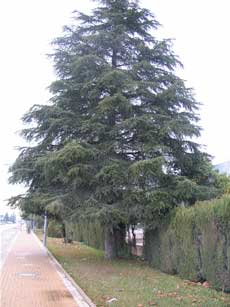
Seto mal ubicado debajo del árbol.
A esto se añade el hecho de que no todos los árboles tienen el mismo sistema radicular: unas especies se extienden de manera horizontal, que son las que mayores daños pueden causar, y otras profundizan más en el terreno. De todos modos las pautas de crecimiento vendrán marcadas, en gran medida, por las características del suelo, como la humedad, los nutrientes, la textura o la profundidad.
Otros elementos a tener en cuenta a la hora de seleccionar las especies a colocar, son sus características ornamentales: si nos interesa que sean de hoja caduca o perenne, que den mayor o menor grado de sombra según la estación, valorar qué tipo de frutos generan, si éstos mancharán el suelo o bien si son o no tóxicos o producen alergias, etc.
Deberán evaluarse, asimismo, las distintas alternativas en sistemas de riego (hoy el más extendido es el riego por goteo), llevarse a cabo un programa de prevención y seguimiento de las posibles plagas y enfermedades, además de realizar tratamientos fitosanitarios periódicos, así como la conveniencia de la poda, factor en el que se han venido cometiendo, según los expertos en la materia, los mayores errores. Por último es recomendable evitar los monocultivos, pues éstos favorecen el desarrollo que las plagas monófagas y, además hacen que nuestras calles caigan en la monotonía; introducir diversidad de especies favorecerá, además, la existencia de fauna urbana.
